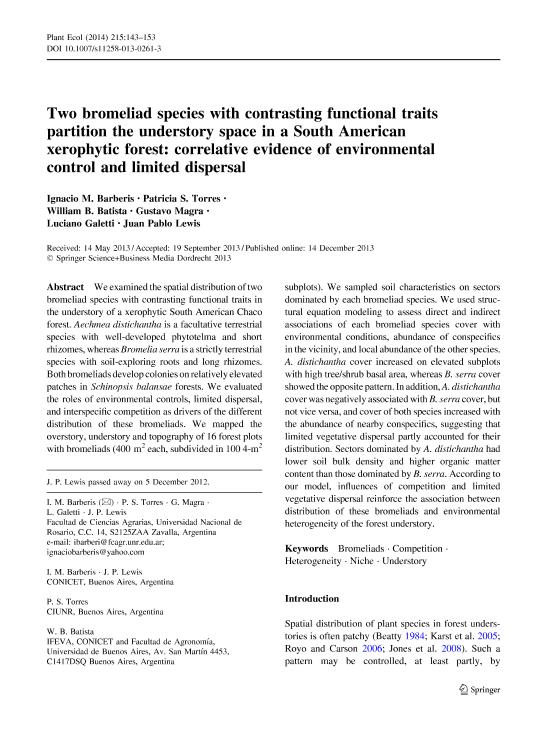Mostrar el registro sencillo del ítem
dc.contributor.author
Barberis, Ignacio Martín

dc.contributor.author
Torres, Patricia S.
dc.contributor.author
Batista, William B.

dc.contributor.author
Magra, Gustavo
dc.contributor.author
Galetti, Luciano Alberto

dc.contributor.author
Lewis, Juan Pablo

dc.date.available
2017-12-07T14:18:29Z
dc.date.issued
2014-02
dc.identifier.citation
Barberis, Ignacio Martín; Torres, Patricia S.; Batista, William B.; Magra, Gustavo; Galetti, Luciano Alberto; et al.; Two bromeliad species with contrasting functional traits partition the understory space in a South American xerophytic forest: correlative evidence of environmental control and limited dispersal; Springer; Plant Ecology; 215; 2; 2-2014; 143-153
dc.identifier.issn
1385-0237
dc.identifier.uri
http://hdl.handle.net/11336/29921
dc.description.abstract
We examined the spatial distribution of two bromeliad species with contrasting functional traits in the understory of a xerophytic South American Chaco forest. Aechmea distichantha is a facultative terrestrial species with well-developed phytotelma and short rhizomes, whereas Bromelia serra is a strictly terrestrial species with soil-exploring roots and long rhizomes. Both bromeliads develop colonies on relatively elevated patches in Schinopsis balansae forests. We evaluated the roles of environmental controls, limited dispersal, and interspecific competition as drivers of the different distribution of these bromeliads. We mapped the overstory, understory and topography of 16 forest plots with bromeliads (400 m2 each, subdivided in 100 4-m² subplots). We sampled soil characteristics on sectors dominated by each bromeliad species. We used structural equation modeling to assess direct and indirect associations of each bromeliad species cover with environmental conditions, abundance of conspecifics in the vicinity, and local abundance of the other species. A. distichantha cover increased on elevated subplots with high tree/shrub basal area, whereas B. serra cover showed the opposite pattern. In addition, A. distichantha cover was negatively associated with B. serra cover, but not vice-versa, and cover of both species increased with the abundance of nearby conspecifics, suggesting that limited vegetative dispersal partly accounted for their distribution. Sectors dominated by A. distichantha had lower soil bulk density and higher organic matter content than those dominated by B. serra. According to our model, influences of competition and limited vegetative dispersal reinforce the association between distribution of these bromeliads and environmental heterogeneity of the forest understory.
dc.format
application/pdf
dc.language.iso
eng
dc.publisher
Springer

dc.rights
info:eu-repo/semantics/openAccess
dc.rights.uri
https://creativecommons.org/licenses/by-nc-sa/2.5/ar/
dc.subject
Bromeliads
dc.subject
Competition
dc.subject
Heterogeneity
dc.subject
Niche
dc.subject
Understory
dc.subject.classification
Otras Ciencias Biológicas

dc.subject.classification
Ciencias Biológicas

dc.subject.classification
CIENCIAS NATURALES Y EXACTAS

dc.title
Two bromeliad species with contrasting functional traits partition the understory space in a South American xerophytic forest: correlative evidence of environmental control and limited dispersal
dc.type
info:eu-repo/semantics/article
dc.type
info:ar-repo/semantics/artículo
dc.type
info:eu-repo/semantics/publishedVersion
dc.date.updated
2017-12-06T17:03:12Z
dc.journal.volume
215
dc.journal.number
2
dc.journal.pagination
143-153
dc.journal.pais
Alemania

dc.journal.ciudad
Berlin
dc.description.fil
Fil: Barberis, Ignacio Martín. Universidad Nacional de Rosario. Facultad de Ciencias Agrarias; Argentina. Consejo Nacional de Investigaciones Científicas y Técnicas; Argentina
dc.description.fil
Fil: Torres, Patricia S.. Universidad Nacional de Rosario. Facultad de Ciencias Agrarias; Argentina. Universidad Nacional de Rosario. Consejo de Investigaciones; Argentina
dc.description.fil
Fil: Batista, William B.. Consejo Nacional de Investigaciones Científicas y Técnicas. Oficina de Coordinación Administrativa Parque Centenario. Instituto de Investigaciones Fisiológicas y Ecológicas Vinculadas a la Agricultura. Universidad de Buenos Aires. Facultad de Agronomía. Instituto de Investigaciones Fisiológicas y Ecológicas Vinculadas a la Agricultura; Argentina
dc.description.fil
Fil: Magra, Gustavo. Universidad Nacional de Rosario. Facultad de Ciencias Agrarias; Argentina
dc.description.fil
Fil: Galetti, Luciano Alberto. Universidad Nacional de Rosario. Facultad de Ciencias Agrarias; Argentina. Consejo Nacional de Investigaciones Científicas y Técnicas; Argentina
dc.description.fil
Fil: Lewis, Juan Pablo. Universidad Nacional de Rosario. Facultad de Ciencias Agrarias; Argentina. Consejo Nacional de Investigaciones Científicas y Técnicas; Argentina
dc.journal.title
Plant Ecology

dc.relation.alternativeid
info:eu-repo/semantics/altIdentifier/doi/http://dx.doi.org/10.1007/s11258-013-0261-3
dc.relation.alternativeid
info:eu-repo/semantics/altIdentifier/url/https://link.springer.com/article/10.1007%2Fs11258-013-0261-3
Archivos asociados
